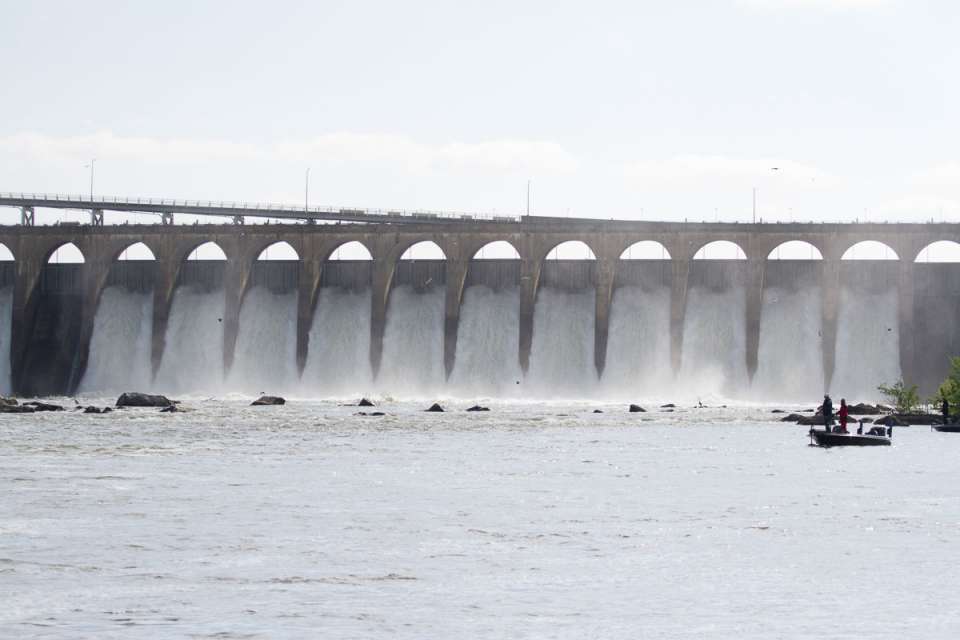
Make a fall trek to Pickwick Lake and you get the better of two bass fishing worlds. Those are catching numbers of schooling largemouth and doing that with topwater lures.
Tennessee native Brandon Lester likes to do both, and he encourages visitors to plan a trip to enjoy the action, with a bonus.
“The tailrace below Wilson Dam is legendary for producing big smallmouth, and those fight harder in that current,” he said.
Lester is referring to the “Shoals” section that stretches from the Wilson Dam tailrace to the end of Seven Mile Island. Swift water from the dam creates strong currents preferred by smallmouth.
Even better, your fall trip offers cooler temperatures and changing leaves, which is all the more reason to visit. The smallmouth and largemouth water covers much of the lake, providing plenty of angling opportunities to pattern and catch both.
The breakdown begins with the smallmouth pattern below the tailrace. Lester calls the first two miles most productive as the smallmouth set up inside current edges.
“They just gorge themselves as schools of shad come past them,” he said. “Just keep in mind this pattern is all about current breaks.”
If the current is strong, he suggests setting up a drift and focus casting a topwater or soft plastic jerkbait into the slack current. That strike zone is created by points, isolated rockpiles, bluff walls, bridges and other manmade structure that break the current flow.
Look for the largemouth bite down lake around the Natchez Trace Parkway bridge. Venture into the creeks where the vegetation grows across shallow flats bordering the winding creek channels. The combination of depth and cover provide prime largemouth habitat.
“In fall the largemouth will come out of the main lake, migrate to the backs of the creeks, and set up in the grass,” he explained. “Along the grass edges are where they will stage to feed on the shad.”
Find the birds, find the bass. That is how simple the pattern works.
“Look for diving gulls and when you find them it’s a telltale sign of schooling largemouth,” he added.
Pinpoint casts are a must with the topwater.
“It is very important to make the bait land on their head, and as soon as you see the fish breaking the surface,” he said.
Do that and you are likely in business. As the water cools more shad migrate into the creeks, and the largemouth follow.
Pickwick Lake has a worthy pedigree that ranks high on Bassmaster Magazine’s Top 100 Bass Lakes rankings. The lake shows out in the fall, for largemouth and smallmouth, and there is much else to see and do in the area.
Gear up: Lester ties on the classic Heddon Super Spook Jr. in a bone color. “It’s great for making long casts and has a really loud, knocking sound that the fish just cannot resist.” What else they can’t stand is the white feathered treble hook added to the back. “It looks like the tail of a shad and I get a lot of hookups on just that rear treble.” Another add-on is the shock-absorbing six-foot leader of 15-pound Vicious Fluorocarbon tied ahead of the 30-pound Vicious No Fade Braid. To complete the rig, he uses a self-assembled Mud Hole Custom Tackle MHX Rod, choosing a 7′ medium action rod. For a more subtle presentation he gears up with an X Zone Lures Whiplash Shad, hooked to a 4/0 Mustad Grip-Pin Big Bite Soft Plastics Hook. A 7′ medium/heavy MHX Rod and 15-pound Vicious Fluorocarbon complete the setup.
About the lake: Pickwick Lake runs 50 miles on the Tennessee River from Wilson Dam in Florence, Alabama, to Pickwick Dam in Tennessee. The lake has 490 miles of shoreline and covers about 47,000 square acres of water surface.
Other fun: Pickwick Landing State Park is an ideal base for your trip, with the park located 14 miles south of the dam. Accommodations include an inn with 119 rooms, each with a picturesque view of the lake. A restaurant, cabins, and camping for tents and RVs add to the amenities. Guests can enjoy golfing, birding, picnicking, disc golf, nature walks and more. The part contains 1,416 acres of forested hills and hollows.
Plan your trip: tnvacation.com




